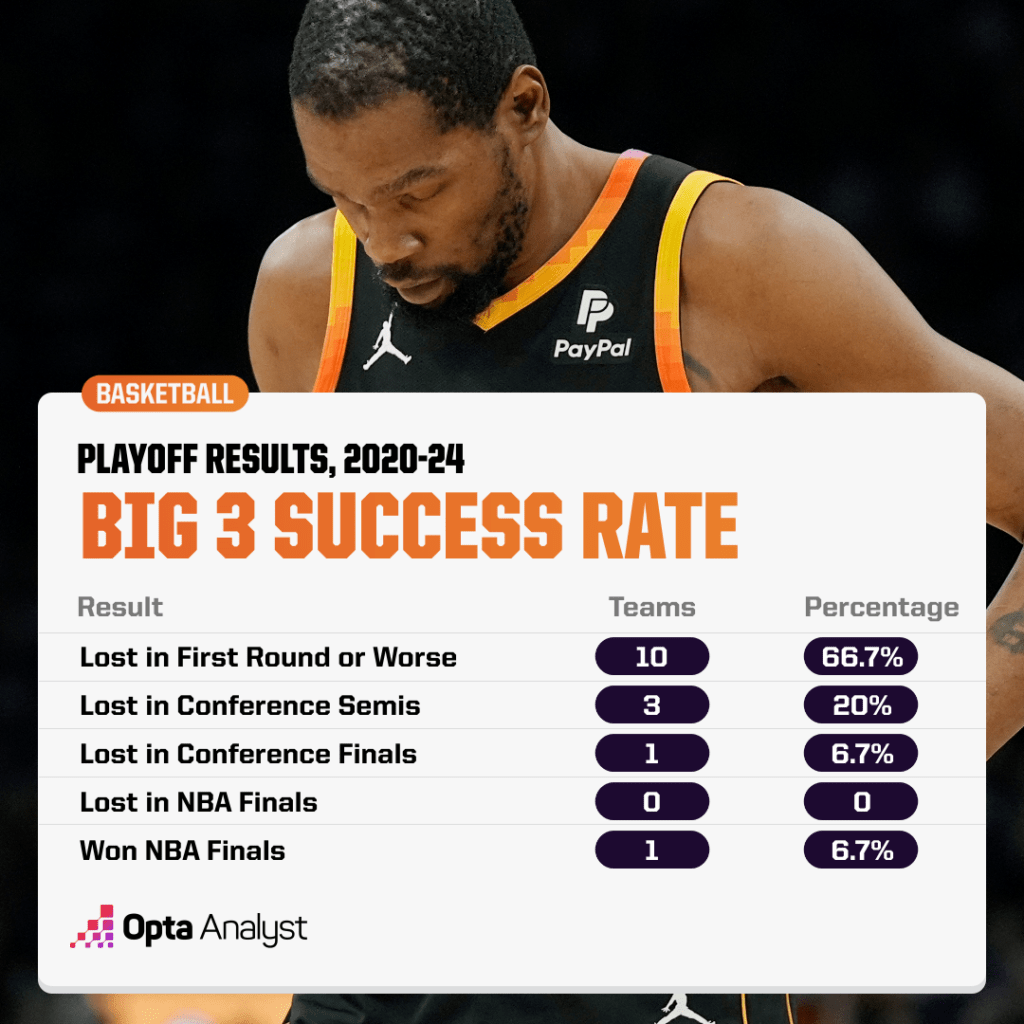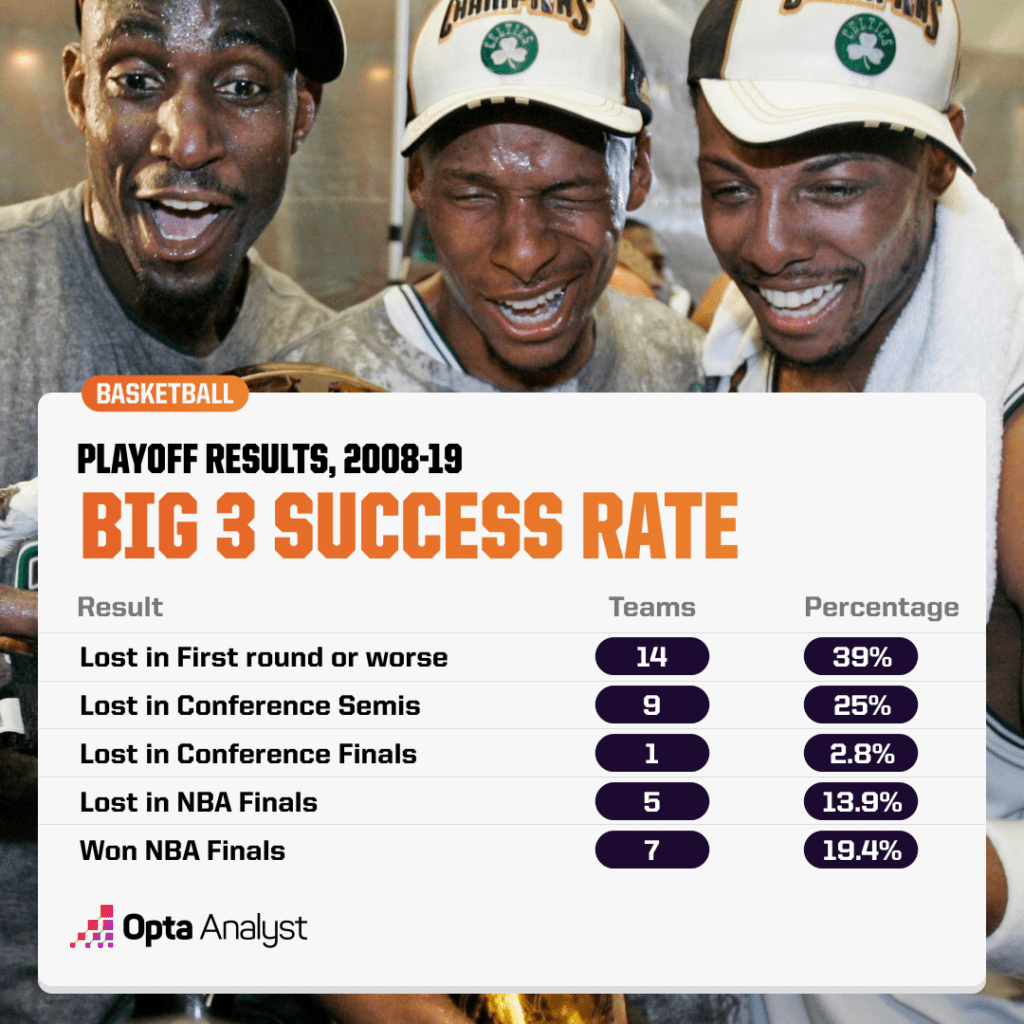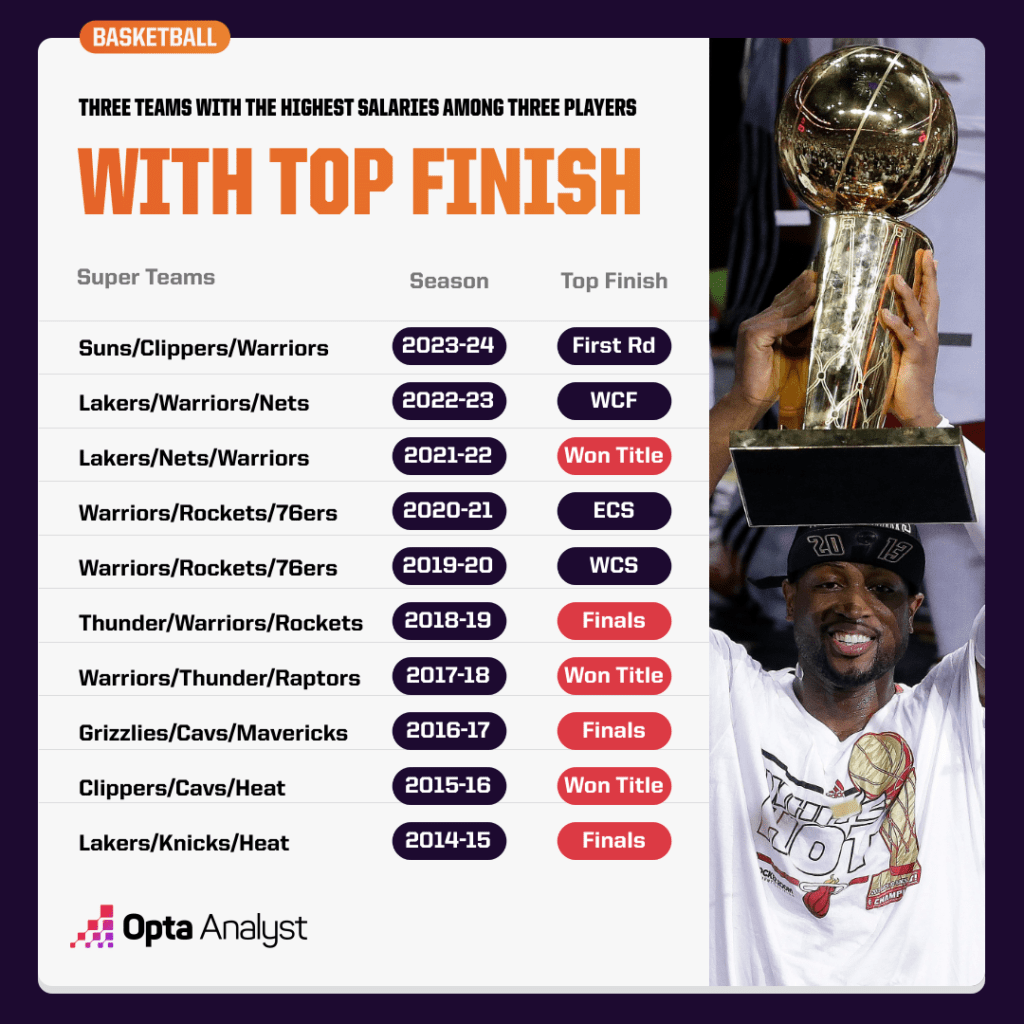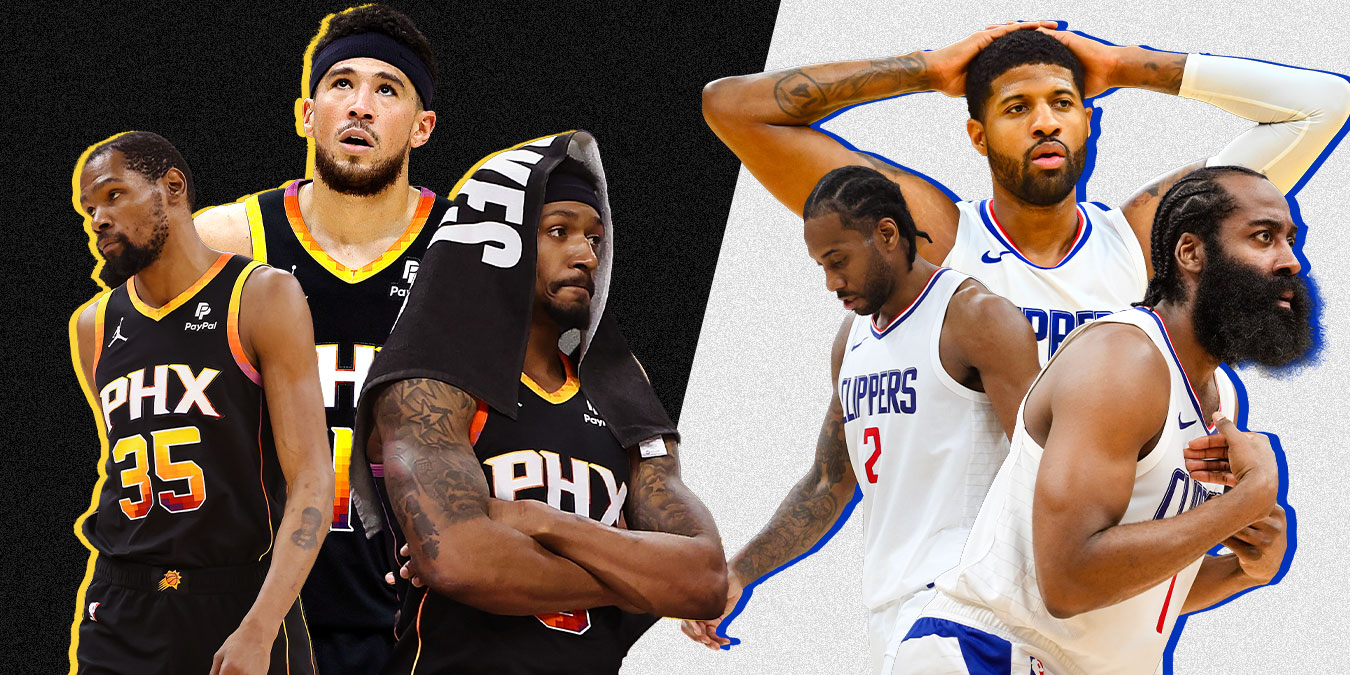The three clubs that met our “Super Team” criteria this season didn’t make it out of the first round. That was hardly unusual. These types of teams have been failing quite often of late. So it seems appropriate to ask: Is the NBA Super Team a thing of the past?
Every NBA fan of a certain age remembers when LeBron James took his talents to South Beach to join Dwyane Wade and the newly signed Chris Bosh and form a “Big 3” in Miami that would go on to win two NBA titles.
But the Big 3 era started really stated in 2007. It was just orchestrated by an Eastern Conference executive instead of three star players. Danny Ainge traded for both Ray Allen and Kevin Garnett, joining them with Paul Pierce and point guard Rajon Rondo and leading the Boston Celtics to a championship in the trio’s first season together.
Since that season, several teams in the league have been trying to put together their version of the “Super Team.” And for a while, this kind of team building worked very well. Get three star levels playing together, grab veterans looking for a title shot on minimums, develop a couple draft picks, use your exceptions well and… voila! Title contender.
Lately, though, these types of teams have been failing at a rate that suggests this model of team build is not an efficient one. Has anything changed, or is it random chance that these teams haven’t been as good the last five years?
And why is this model even less likely to work in the future?
The Big 3 Era
How are we defining our Super Teams? They’re the three teams with the highest amount of salary going to the three most expensive players. So we’ve taken a look at such clubs for each year since what we deem the start of the Big 3 era – after the 2007-08 season.
In 2023-24, the Phoenix Suns are paying premier scorers Kevin Durant, Bradley Beal and Devin Booker over $130 million, more than any other trio in the league on the same team. The other teams? The Los Angeles Clippers (Paul George, Kawhi Leonard, Russell Westbrook) and the Golden State Warriors (Steph Curry, Klay Thompson, Chris Paul).
Of course, none of these teams made it out of the first round in the Western Conference playoffs. And coming up short has been a common occurrence for these teams in the last five years.

If you compare that with the success rate of these teams from 2008-19, you’ll notice how much better the results for these team builds were in the earlier years.

The only team to even make the NBA Finals, let alone win it, in the past five years with one of the three-highest paid trios in the league was the 2022 Warriors. Though Draymond Green did make $24 million that year, fourth on the team.
In the 12 years before that, over half of the NBA championships were won by teams with one of the three-highest paid trios in the league. And it wasn’t a case of one franchise winning all these titles, either – five different franchises won the seven titles.
The Flaw in the Build
So why have these teams stopped winning at a high rate? One of the reasons is the increased demands of the teams trading superstars.
It’s extremely difficult to time contracts well enough to sign three different players to veteran maximum contracts in free agency or through the draft. The Miami Heat were able to do it by purging their cap sheet of almost everybody to sign LeBron and Chris Bosh while re-signing Dwyane Wade, and the Warriors were able to sign Durant while having Green, Thompson and Curry’s contracts on the books due to an unprecedented cap spike that the league and NBA players union have agreed to not let happen again the new CBA.
That means acquiring three superstars on maximum salaries will usually require one of the players to be added via trade. And the asking price for superstars on max deals has been astronomical over the past five years.
Take the trades of the Celtics and Los Angeles Lakers in the 2000s. The Celtics gave up two first-round picks and a package of players highlighted by Al Jefferson for Garnett, who had been an All Star the previous seven years. Then Boston traded the draft rights to Jeff Green along with Wally Szczerbiak and Delonte West for Glen Davis and Allen. Allen had made the four previous All-Star games.
The Lakers were desperate to pair another true superstar with Kobe Bryant and traded a group of players highlighted by Kwame Brown and two first-round picks for Pau Gasol. The Grizzlies also got the rights of Marc Gasol, which turned out to be great, but at the time were the rights of an unknown player selected 48th overall in the 2007 draft. The Celtics and Lakers would go on to win titles with rosters that included two highly paid players acquired by trade. (The Celtics with Garnett and Allen in 2008 and the Lakers with Lamar Odom and Gasol in 2009).
That’s five total first rounders for three future Hall of Famers who were already established players. The Minnesota Timberwolves had to give up five first rounders (including Walker Kessler) and a pick swap just to get Rudy Gobert ahead of the 2022-23 season. The Brooklyn Nets got four first-round picks, a pick swap and Mikal Bridges for Durant.
Inflation has hit NBA GMs hard, too. And the price on these deals is dramatically higher. Basically, if you want a difference-making MVP-caliber player in his prime, in normal circumstances, the player now costs every draft asset you own.
When teams empty the cupboard for one player, it leaves very few assets left to obtain other players. The Suns struggled to find enough players to fill out a competent rotation this year. They gambled on the Bradley Beal trade in the first place because their only assets left after the Durant trade were pick swaps and the team could only get involved in bidding wars for more distressed assets.
So, even though Beal wasn’t the perfect fit, he was the best player the Suns thought they could get. After the Beal trade, most of the roster tweaking had to be done with minimum contracts, and it led to a team that wasn’t deep enough in the playoffs.

In previous years, the Suns would’ve had access to the taxpayer’s mid-level exception, which would’ve allowed them to sign one or more players for above the minimum. But, starting in 2023-24, that exception was taken away from teams over the newly added second apron, designed to curb spending.
Even for teams in the first apron of tax spending, it’s been harder to get quality players with the taxpayer’s mid-level exception than it was in the past due to the increasing disparity between the taxpayer’s mid-level exception and non-taxpayers mid-level exception. The difference between the mid-level offered to teams in the tax and teams over the cap but under the tax in 2011-12 was just $2 million. This year, that difference is $7,405,000. It’s a lot easier to talk a good player into taking $2 million less for a chance to play with some All-NBA players than it is to ask a player to take almost $7.5 million less.
Superstars cost more than ever and acquiring talent to round out the roster with a bloated cap sheet is harder than ever. This makes the margin for success with this type of team build so thin that teams have to hit on almost every transaction to build a championship-level team. And if there are any missteps, the optionality of this team build has been reduced so drastically that teams are usually stuck for a few years without anyway to improve.
The New CBA
The absence of a mid-level exception for teams over the second apron was just the start of new penalties for teams spending a lot of money. Teams over the second apron are facing even stricter rules next year.
They aren’t going to be able to make trades in which they send out more salary than they take in, cannot send out cash in trades and cannot trade a first-round pick seven years out (among other restrictions).
According to Sam Quinn of CBS Sports, these restrictions would’ve made KD’s trade to the Suns trade and James Harden’s trade from the Houston Rockets to the Nets illegal as they were constructed.
If you’re paying three players top dollar, chances are your team will be in or close to the second apron. The second apron was just under $183 million this year, and the Suns paid their top three players $130 million. That leaves $53 million for the rest of the roster.
So, it’s harder than ever to make this roster build tenable and harder to even put together the three stars with the trade restrictions. This means we’ll likely see a lot fewer teams try to have three veteran maximum contracts at the same time.
How Will Teams Adjust?
It will be interesting to see how teams that may have tried this roster build in the past adjust in the offseasons to come. It’s possible some teams try to be more aggressive while their stars are on rookie contracts.
The Timberwolves made the Gobert trade betting that Anthony Edwards would be ready to lead a contender while his cap hit percentage was under 10%. He was able to do that this year, but it will lead to some difficult decisions next year, as he will be on a rookie max contract and the team’s salary will climb even more.
A lot of teams will likely opt to surround two veteran max players with good players instead of a third veteran maximum. The ideal team build may be two elite players on veteran maximums, a player who can be the third-best player on a rookie deal, and several good complementary players to fill out the roster.
Still, some teams may opt to try building a contender while in the second apron with three huge contracts because it’s the only, or one of the only, paths forward. Minnesota has to decide whether to break up one of the best teams in franchise history or risk losing all optionality. The Denver Nuggets face the same dilemma as the team hovers around the second apron next season without any extra salary.
And the Los Angeles Lakers weren’t able to put the right players around Anthony Davis and LeBron this year to field a true contender (they do have that regular-season tournament banner to raise). If the opportunity to add a third star presents itself this summer, the team might still see that as a better short-term play than running it back with the current roster.
The point of the new CBA was to make life tougher on teams that pay well into the luxury tax. And with the likelihood of that to succeed, the three maximum-contract model is less viable than ever.
Research support provided by Stats Perform’s Tom Paquette. Check out all our MLB, NBA and NFL coverage. And follow us on X and Instagram for more!
